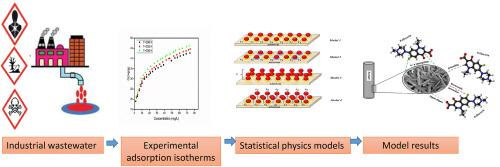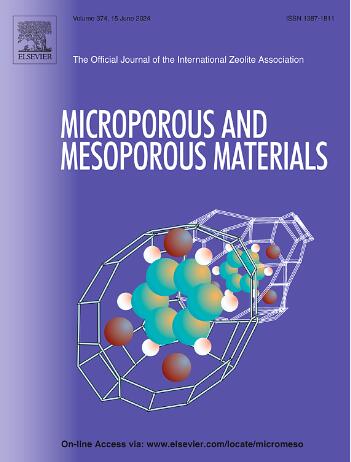Exploring statistical physics principles for superior Pefloxacin extraction from water via halloysite nanotubes: Stereographic and topographic evaluation
IF 4.8
3区 材料科学
Q1 CHEMISTRY, APPLIED
引用次数: 0
Abstract
This novel research incorporates statistical physics methodologies to microscopically scrutinize and interpret the retention dynamics of Pefloxacin from aqueous solutions via Halloysite Nanotubes (HNTs) for water detoxification. Measurement points were matched under the scope of four distinct statistical isotherm frameworks: the single-energy monolayer, dual-energy monolayer, tri-energetic monolayer, and dual-energy bilayer. An error quantification approach, incorporating R2, reduced Chi-Square, RSS, and R2adj, identified the dual-energy bilayer as the most suitable model. Rooted in the more realistic scenario, stereographic, energetic and thermodynamic parameters in addition to the pore size distribution (PSD) and adhesion energy distribution (AED) functions have been successfully developed and applied to examine the intricate details of the docking mechanisms. Stereographic examination unveiled that the linking cavities preferentially capture a majority of the attached species with n > 1 at specific temperatures indicating a specific-anchorage mechanism with substantial aggregation. Statistical thermodynamic exploration evidenced that the retention operation in this study is entropy-driven, and endothermic. Combining temperature and concentration impacts gives entropy a more complex behavior. Finally, the PSD and AED assessments revealed the mesoporous geometric size and energetic surface heterogeneity confirming the endothermic nature and physisorption-dominated mechanism (<25 kJ/mol) of the Pefloxacin/HNTs area-anchoring.

探索通过哈洛石纳米管从水中提取优质培氟沙星的统计物理原理:立体和形貌评估
这项新颖的研究结合了统计物理学方法,从显微镜下仔细观察和解释了水溶液中的培氟沙星通过霍洛石纳米管(HNTs)进行水解毒的滞留动力学。在四种不同的统计等温线框架下对测量点进行了匹配:单能单层、双能单层、三能单层和双能双层。采用误差量化方法,结合 R2、缩小的 Chi-Square 值、RSS 和 R2adj,确定双能双分子层为最合适的模型。基于更现实的情况,除了孔径分布(PSD)和粘附能分布(AED)函数外,还成功开发并应用了立体参数、能量参数和热力学参数,以研究对接机制的复杂细节。立体学研究发现,在特定温度下,连接空腔优先捕获了大部分附着物种(n > 1),这表明了具有大量聚集的特异性锚定机制。统计热力学探索证明,本研究中的保留操作是熵驱动和内热的。结合温度和浓度的影响,熵的行为更为复杂。最后,PSD 和 AED 评估显示了介孔几何尺寸和能量表面异质性,证实了培氟沙星/HNTs 区域锚定的内热性质和物理吸附主导机制(<25 kJ/mol)。
本文章由计算机程序翻译,如有差异,请以英文原文为准。
求助全文
约1分钟内获得全文
求助全文
来源期刊

Microporous and Mesoporous Materials
化学-材料科学:综合
CiteScore
10.70
自引率
5.80%
发文量
649
审稿时长
26 days
期刊介绍:
Microporous and Mesoporous Materials covers novel and significant aspects of porous solids classified as either microporous (pore size up to 2 nm) or mesoporous (pore size 2 to 50 nm). The porosity should have a specific impact on the material properties or application. Typical examples are zeolites and zeolite-like materials, pillared materials, clathrasils and clathrates, carbon molecular sieves, ordered mesoporous materials, organic/inorganic porous hybrid materials, or porous metal oxides. Both natural and synthetic porous materials are within the scope of the journal.
Topics which are particularly of interest include:
All aspects of natural microporous and mesoporous solids
The synthesis of crystalline or amorphous porous materials
The physico-chemical characterization of microporous and mesoporous solids, especially spectroscopic and microscopic
The modification of microporous and mesoporous solids, for example by ion exchange or solid-state reactions
All topics related to diffusion of mobile species in the pores of microporous and mesoporous materials
Adsorption (and other separation techniques) using microporous or mesoporous adsorbents
Catalysis by microporous and mesoporous materials
Host/guest interactions
Theoretical chemistry and modelling of host/guest interactions
All topics related to the application of microporous and mesoporous materials in industrial catalysis, separation technology, environmental protection, electrochemistry, membranes, sensors, optical devices, etc.
 求助内容:
求助内容: 应助结果提醒方式:
应助结果提醒方式:


